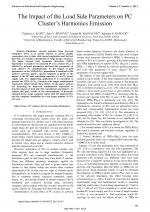| 1/2011 - 17 |
The Impact of the Load Side Parameters on PC Cluster's Harmonics EmissionKATIC, V. A. |
| Extra paper information in |
| Click to see author's profile in |
| Download PDF |
Author keywords
PC clusters, power conversion, harmonics
References keywords
power(17), harmonics(8), harmonic(8), transaction(7), phase(6), loads(6), delivery(6), single(5), effects(5), current(5)
Blue keywords are present in both the references section and the paper title.
About this article
Date of Publication: 2011-02-27
Volume 11, Issue 1, Year 2011, On page(s): 103 - 110
ISSN: 1582-7445, e-ISSN: 1844-7600
Digital Object Identifier: 10.4316/AECE.2011.01017
Web of Science Accession Number: 000288761800017
SCOPUS ID: 79955954061
Abstract
Harmonics current emission from personal computers (PCs) is of special interest to power quality researchers, due to their wide spread application and the fact that they are usually concentrated in large groups (clusters). The input current total harmonic distortion (THDI) dependence on number of connected PCs in a cluster (NPC) is affected by network parameters and load side parameters of each cluster's PC simultaneously. As the impact of grid parameters on the THDI=f(NPC) dependence is analyzed in the author's previous papers, special emphasis is given on the impact of the DC side smoothing capacitor (C) in PCs power supply unit. For engineering application it is convenient to present the THDI=f(NPC) function with simple mathematical expressions which include these effects. In the paper authors are proposing an improved mathematical expression to presents impact of load side (DC capacitance) parameters. To achieve this goal, results of the measurements of harmonic emission from a large computer center with 167 clustered PCs and the computer simulation for even larger number of PCs are used. |
| References | | | Cited By |
Web of Science® Times Cited: 6 [View]
View record in Web of Science® [View]
View Related Records® [View]
Updated 2 weeks, 5 days ago
SCOPUS® Times Cited: 7
View record in SCOPUS® [Free preview]
View citations in SCOPUS® [Free preview]
[1] Statistical Study of Personal Computer Cluster Harmonic Currents from Experimental Measurements, Mesas, Juan José, Sainz, Luis, Sala, Pau, Electric Power Components and Systems, ISSN 1532-5008, Issue 1, Volume 43, 2015.
Digital Object Identifier: 10.1080/15325008.2014.963263 [CrossRef]
[2] Harmonic Contributions of Utility and Customer Based on Load Model Using Field Measurements, Gül, Ömer, Gündoğdu, Tayfun, Journal of Power and Energy Engineering, ISSN 2327-588X, Issue 05, Volume 03, 2015.
Digital Object Identifier: 10.4236/jpee.2015.35002 [CrossRef]
[3] Least Squares Modeling of Voltage Harmonic Distortion Due to PC Cluster Operation, MUJOVIC, S., DJUKANOVIC, S., RADULOVIC, V., KATIC, V., RASOVIC, M., Advances in Electrical and Computer Engineering, ISSN 1582-7445, Issue 4, Volume 13, 2013.
Digital Object Identifier: 10.4316/AECE.2013.04022 [CrossRef] [Full text]
[4] Multi-parameter mathematical model for determination of PC cluster total harmonic distortion of input current, Mujovic, Sasa, Djukanovic, Slobodan, Radulovic, Vladan, Katic, Vladimir A., COMPEL: The International Journal for Computation and Mathematics in Electrical and Electronic Engineering, ISSN 0332-1649, Issue 1, Volume 35, 2016.
Digital Object Identifier: 10.1108/COMPEL-03-2015-0149 [CrossRef]
[5] Monitoring and analysis of power quality in electric vehicle charging stations, Li, Qiushuo, Tao, Shun, Xiao, Xiangning, Wen, Jianfeng, 2013 1st International Future Energy Electronics Conference (IFEEC), ISBN 978-1-4799-0073-2, 2013.
Digital Object Identifier: 10.1109/IFEEC.2013.6687516 [CrossRef]
Disclaimer: All information displayed above was retrieved by using remote connections to respective databases. For the best user experience, we update all data by using background processes, and use caches in order to reduce the load on the servers we retrieve the information from. As we have no control on the availability of the database servers and sometimes the Internet connectivity may be affected, we do not guarantee the information is correct or complete. For the most accurate data, please always consult the database sites directly. Some external links require authentication or an institutional subscription.
Web of Science® is a registered trademark of Clarivate Analytics, Scopus® is a registered trademark of Elsevier B.V., other product names, company names, brand names, trademarks and logos are the property of their respective owners.
Faculty of Electrical Engineering and Computer Science
Stefan cel Mare University of Suceava, Romania
All rights reserved: Advances in Electrical and Computer Engineering is a registered trademark of the Stefan cel Mare University of Suceava. No part of this publication may be reproduced, stored in a retrieval system, photocopied, recorded or archived, without the written permission from the Editor. When authors submit their papers for publication, they agree that the copyright for their article be transferred to the Faculty of Electrical Engineering and Computer Science, Stefan cel Mare University of Suceava, Romania, if and only if the articles are accepted for publication. The copyright covers the exclusive rights to reproduce and distribute the article, including reprints and translations.
Permission for other use: The copyright owner's consent does not extend to copying for general distribution, for promotion, for creating new works, or for resale. Specific written permission must be obtained from the Editor for such copying. Direct linking to files hosted on this website is strictly prohibited.
Disclaimer: Whilst every effort is made by the publishers and editorial board to see that no inaccurate or misleading data, opinions or statements appear in this journal, they wish to make it clear that all information and opinions formulated in the articles, as well as linguistic accuracy, are the sole responsibility of the author.



